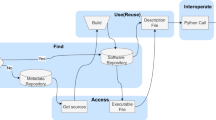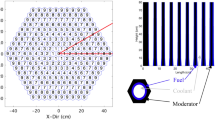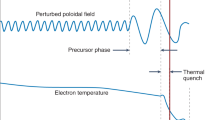Abstract
ITER is the flagship fusion project, conceived as an experiment to select and develop the technologies for the first demonstration reactor, DEMO. Nuclear analysis is a core discipline in support of the design, commissioning and operation of the machine. To date, it has been conducted with increasingly detailed partial models, which represented toroidal segments of the tokamak. However, the limitations of this methodology became evident as estimates of quantities relevant to design, safety and operation showed unquantifiable uncertainties, which is a risk. Here, we present a detailed and realistic 360° MCNP model of the ITER tokamak called E-lite. We demonstrate the model’s usability and practicality. Two examples are used to illustrate qualitatively and quantitatively how it solves previously intractable problems with marked benefits for the future nuclear analysis of ITER, with applications to DEMO and future reactors. E-lite constitutes a milestone in the field of nuclear analysis in terms of realism in the evaluation of key quantities.
This is a preview of subscription content, access via your institution
Access options
Access Nature and 54 other Nature Portfolio journals
Get Nature+, our best-value online-access subscription
$29.99 / 30 days
cancel any time
Subscribe to this journal
Receive 12 digital issues and online access to articles
$119.00 per year
only $9.92 per issue
Buy this article
- Purchase on Springer Link
- Instant access to full article PDF
Prices may be subject to local taxes which are calculated during checkout




Similar content being viewed by others
Data availability
Data and the model are the intellectual property of the ITER Organization. Data of the main text and the supplementary information will be made available upon reasonable request after the recipients confirm in writing that the purpose of obtaining the data is only to reproduce the results and after the recipients have signed and returned a non-disclosure agreement confirming that no part of the data will be distributed in any way. Data for the tritium breeding module ports will not be made available, as they are subject to additional intellectual property restrictions.
Code availability
The MCNP5 v.1.60 code2 is distributed by the Radiation Safety Information Computational Center (RSICC, Oak Ridge National Laboratory) under user licences, following the procedure provided online (https://mcnp.lanl.gov/mcnp_how_to_get_to_mcnp.shtml). The D1SUNED v.3.1.4 code11, which is developed by UNED, is a proprietary patch-code to MCNP5 v.1.60. The code will be made available on reasonable request after the recipients confirm in writing that the purpose of obtaining the code is only to reproduce the results and after the recipients have signed and returned a non-disclosure agreement confirming that no part of the code will be distributed in any way.
References
Wu, Y. et al. Identification of safety gaps for fusion demonstration reactors. Nat. Energy 1, 16154 (2016).
X-5 Monte Carlo Team. MCNP—A General Monte Carlo N-Particle Transport Code, Version 5. Vol. I: Overview and Theory Report No. LA-UR-03-1987 (Los Alamos National Laboratory, 2003).
Leichtle, D. et al. The ITER tokamak neutronics reference model C-Model. Fusion Eng. Des. 136, 742–746 (2018).
Pereslavtsev, P. et al. Modelling and shielding analysis of the neutral beam injector ports in ITER. Fusion Eng. Des. 98–99, 1585–1588 (2015).
Yang, J., Wilson, S. C., Mosher, S. W. & Radulescu, G. Integration of the full tokamak reference model with the Complex model for ITER neutronics analysis. Fusion Sci. Technol. 74, 277–287 (2018).
Alguacil, J., Sauvan, P., Juarez, R. & Catalan, J. P. Assessment and optimization of MCNP memory management for detailed geometry of nuclear fusion facilities. Fusion Eng. Des. 136, 386–389 (2018).
Juárez, R. et al. Shutdown dose rates at ITER equatorial ports considering radiation cross-talk from torus cryopump lower port. Fusion Eng. Des. 100, 501–506 (2015).
Travleev, A. et al. Nuclear analysis of the ITER In-Vessel viewing system. Fusion Eng. Des. 136, 247–251 (2018).
Juárez, R. et al. ITER plasma source and building modelling to produce radiation maps. Nucl. Fusion 58, 126012 (2018).
Pampin, P. et al. Overview of nuclear integration activities for mitigation of radiation loads to ITER superconducting magnets. Trans. Am. Nucl. Soc. 116, 247–250 (2017).
Sauvan, P. et al. D1SUNED system for the determination of decay photon related quantities. Fusion Eng. Des. 151, 111399 (2020).
Mosher, S. W. & Wilson, S. C. Algorithmic improvements to MCNP5 for high-resolution fusion neutronics analyses. Fusion Sci. Technol. 74, 263–276 (2018).
van Wijk, A. J., Van den Eynde, G. & Hoogenboom, J. E. An easy to implement global variance reduction procedure for MCNP. Ann. Nucl. Energy 38, 2496–2503 (2011).
Batistoni, P. On the absolute calibration of neutron measurement in fusion reactors. Fusion Eng. Des. 105, 58–69 (2016).
Bertalot, L. et al. Present status of ITER neutron diagnostics development. J. Fusion Energy 38, 283–290 (2019).
Snoj, L. et al. Neutronic analysis of JET external neutron monitor response. Fusion Eng. Des. 109–111, 99–103 (2016).
Snoj, L. et al. Calculations to support JET neutron yield calibration: modelling of the JET remote handling system. Nucl. Eng. Des. 261, 244–250 (2013).
Strachan, J. D. et al. Neutron calibration techniques for comparison of tokamak results. Rev. Sci. Instrum. 61, 3501–3504 (1990).
Barnes, C. W., Larson, A. R., LeMunyan, G. & Loughlin, M. J. Measurements of DT and DD neutron yields by neutron activation on the Tokamak Fusion Test Reactor. Rev. Sci. Instrum. 66, 888–890 (1995).
Bertalot, L., Roquemore, A. L., Loughlin, M. & Esposito, B. Calibration of the JET neutron activation system for DT operation. Rev. Sci. Instrum. 70, 1137–1140 (1999).
Batistoni, P. et al. 14 MeV calibration of JET neutron detectors—phase 1: calibration and characterization of the neutron source. Nucl. Fusion 58, 026012 (2018).
Batistoni, P. et al. 14 MeV calibration of JET neutron detectors—phase 2: in-vessel calibration. Nucl. Fusion 58, 106016 (2018).
Strachan, J. et al. Absolute calibration of TFTR helium proportional counters. Rev. Sci. Instrum. 66, 1247–1251 (1995).
Stammers, K. & Loughlin, M. J. The calibration of the MAST neutron yield monitors. Nucl. Instrum. Methods Phys. Res. A 562, 521–530 (2006).
Nishitani, T. et al. Absolute calibration of the JT-60U neutron monitors using a 252Cf neutron source. Rev. Sci. Instrum. 63, 4558 (1992).
Isobe, M. et al. Neutron diagnostics in the Large Helical Device. IEEE Trans. Plasma Sci. 46, 2050–2058 (2018).
López-Revelles, A. J. et al. MCNP model of the ITER Tokamak Complex. Fusion Eng. Des. 136, 859–863 (2018).
Ghani, Z. et al. Radiation levels in the ITER tokamak complex during and after plasma operation. Fusion Eng. Des. 96–97, 261–264 (2015).
INR-KIT/numjuggler (GitHub, 2016); https://github.com/inr-kit/numjuggler.
FENDL-3.1d: Fusion Evaluated Nuclear Data Library v.3.1d (International Atomic Energy Agency, 2018); https://www-nds.iaea.org/fendl/
Acknowledgements
This work was carried out using an adaption of the C-model MCNP model that was developed as a collaborative effort between the Amec company (international), Culham Centre for Fusion Energy (United Kingdom), Frascati Research Centre of the National Agency for New Technologies, Energy and Sustainable Economic Development (Italy), FDS Team of the Institute of Nuclear Energy Safety Technology (People’s Republic of China), ITER Organization (France), Japan Atomic Energy Agency in Naka (Japan), National Distance Education University (UNED) (Spain), Fusion for Energy (Spain) and University of Wisconsin – Madison (United States). This work was performed under ITER contract IO/CT/13/6-141 between the ITER Organization and the consortium consisting of UNED and the IDOM Corporation. We appreciate the support given by MINECO for the funding of the Juan de la Cierva-incorporación 2016 programme and funding under I+D+i-Retos Investigación (project ENE2015-70733R), by the Comunidad de Madrid for funding under I+D en Tecnologías (TECHNOFUSIÓN (III)-CM, project S2018/EMT-4437), by the Escuela Técnica Superior de Ingenieros Industriales-UNED 2019 programme, and by UNED for funding of the predoctoral contract (Formación Personal Investigador). We thank L. Bertalot from the ITER Organization for his support and indications in relation to ITER neutron calibration. The views expressed in this publication are the sole responsibility of the authors and do not necessarily reflect the views of Fusion for Energy or of the ITER Organization. Neither of these institutions nor any person acting on their behalf is responsible for the use that might have been made of information in this publication. The content of this paper does not commit the ITER Organization to being a nuclear operator.
Author information
Authors and Affiliations
Contributions
R.J. and G.P., with M.J.L., E.P., R.P. and M.F., conceived the model. G.P. created the model with the support of P.M., M.D.P., J.A., A.J.L.-R. and A.K. R.J. and G.P. conceived the analysis, executed it with the support of P.S. and F.O., and interpreted the data with the support of M.J.L., R.P. and J.S.
Corresponding author
Ethics declarations
Competing interests
The authors declare no competing interests.
Additional information
Peer review information Nature Energy thanks Paul Wilson, Yican Wu and the other, anonymous, reviewer(s) for their contribution to the peer review of this work.
Publisher’s note Springer Nature remains neutral with regard to jurisdictional claims in published maps and institutional affiliations.
Supplementary information
Supplementary Information
Supplementary Figs. 1–4, Table 1, discussion and references
Rights and permissions
About this article
Cite this article
Juarez, R., Pedroche, G., Loughlin, M.J. et al. A full and heterogeneous model of the ITER tokamak for comprehensive nuclear analyses. Nat Energy 6, 150–157 (2021). https://doi.org/10.1038/s41560-020-00753-x
Received:
Accepted:
Published:
Issue Date:
DOI: https://doi.org/10.1038/s41560-020-00753-x
This article is cited by
-
Isotope engineering achieved by local coordination design in Ti-Pd co-doped ZrCo-based alloys
Nature Communications (2024)
-
Assessment of ITER radiation environment during the remote-handling operation of In-Vessel components with D1SUNED
Scientific Reports (2023)



